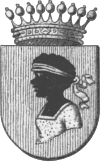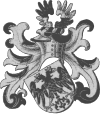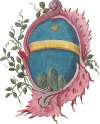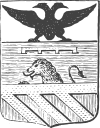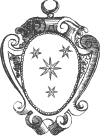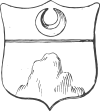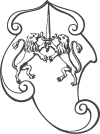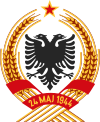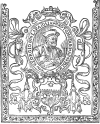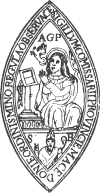Medieval period
Ambiguitatem
| Coat of arms | Description |
|---|---|

|
Coat of arms at the Abbey of Ndërfandina (????) Within the marble beam that held the gate of the monastic cell, at the old abbey of Ndërfandina in Gëziq, the Austrian consul in Shkodër, Theodor Ippen, unearthed an epigraphic inscription from the architrave of the Basilica along with a heraldic coat of arms which featured a stone-carved eagle, with one head and two wings outstretched in flight, clutching a ring on its beak.[2] In 1967, digging through the broken fragments which had been stored at the local museum of Rrëshen, researcher Dhimitër Shuteriqi became convinced that the pieces on the inscription formed the words DIMITRI and PROGON, in reference to the princes of the Progonate family of lords that ruled over the territory now known as the Principality of Arbanon.[3] The fragments discovered in Gëziq were transferred to the Archaeological Museum of Tirana in 1981, to be further examined by conservation specialist Koço Zheku. After meticulously reconstructing the eight pieces of marble, which collectively measured 1.6 meters in length, Zheku managed to decipher the inscription as follows:[4]
His conclusive work, refuting the earlier findings by Shuteriqi, was published in the scientific periodical "Iliria", issue nr.2, p. 219–225, year 1984. At the insistence of government officials, the inscription, unreadable in its entirety, was given a new interpretation by scholar of antiquity Injac Zamputi, reaffirming Shuteriqi's previously ambiguous claims.[5] |

|
Coat of arms of Drivastum (????) Not far from the gates of the citadel of Drivastum, a hewn stone bearing a coat of arms was found by local peasants among the rubble and blocks of stone.
No inscription has been found to give clues as to whether the coat of arms belonged to a Venetian or an Albanian lord. One can only assume that the stone was immured in the gate and tumbled down when the wall collapsed. The coat of arms is one of the few remnants of value where once stood the medieval city of Drivastum.[6] |

|
Tombstone relief at the Berat Citadel (????) First discovered by Austrian archaeologist Carl Patsch, details of the tombstone relief were published in the 1919 work titled "Archäologische Forschungen in Albanien und Montenegro" by Camillo Praschniker and Arnold Schober:[7]
|

|
Coat of arms discovered in Maqellarë (????) During the agricultural activities of the early 1970s, a coat of arms intricately carved from marbled limestone, bearing a closed white hue akin to the marbles found in the Banisht quarry, was discovered in Maqellarë.
This coat of arms is speculatively linked to the Gropa family of feudal lords who ruled over the region from the 12th until the 14th century.[8] |

|
Coat of arms at the Monastery of St. Antonius (15th century) Opposite the town of Alessio, above a hill on the right bank of the Drin river, stands the small Franciscan monastery of St. Antonius. Tradition of the Franciscan order alludes to the founding of this monastery being ascribed to its founder, Francis of Assisi, going back to the 13th century. At the entrance, embedded on the pavement, a tombstone decorated with a coat of arms was found, and later removed, placed alongside the interior wall. The coat of arms is surmounted by an inscription, which is, unfortunately, incomplete.[9] It reads:
The name of the person buried here is not clear from the inscription. The tombstone probably belongs to a Venetian lord, dating from the 15th century, since Alessio was Venetian property at the time.
In contemporary Albanian history, this coat of arms is speculatively attributed to one Anton Scura, a supposed patriarch of the noble Scura family, which held sway over the territories in nearby Delbnisht, present-day Kurbin. No reliable records of an Anton Scura from sources of antiquity have been found. |
Regnum Albaniæ
| Coat of arms | Description |
|---|---|

|
Coat of arms of the Angevin dynasty (1292) Charles I d'Anjou, brother of King Louis IX of France, governed the Kingdom of Naples (and Sicily), during the 13th century. Following the Norman invasion, he extended his rule into Albania, capturing Dyrrhachium and bringing Albanian feudal lords under his control. The Despot of Epirus, who had nominal authority over this region, became his vassal. Charles (I) established the first Albanian kingdom, Regnum Albaniæ, and was declared its King in 1272.[10] The symbols in the Angevin coat of arms are attributed to his grandson and future heir, Philip I, Prince of Taranto.
|
Feudal lords
| Coat of arms | Description |
|---|---|
| Coats of arms of the Dukagjini (14th century) The Dukagjini were a noble Albanian family of feudal lords that ruled parts of northern Albania and western Kosovo throughout the 14th and 15th centuries. A branch of the family fled Ottoman rule and settled in the Venetian-controlled city of Capodistria, joining other Albanian nobility, the Borisi, Bruni and Bruti.[11] Their extensive lineage is documented in Prospero Petronio's manuscript titled "Memorie istoriche sacre e profane dell'Istria e sua metropoli (1680–1681)", which traces the family's roots to Iginus Comnenus, of the Arianiti Comneni clan.[12] Lek Dukagjini, a strong tribal chieftain, gained prominence for his work The Kanun, a set of traditional customary laws that regulated clan relations between the highlanders of northern Albania. His nephew, Giovanni, son of Demetrio, became castellan lord of San Servolo. Other members of the family gradually integrated into Ottoman suzerainty, finding their way to Istanbul where they would achieve high ranks, beginning with Dukaginzade Ahmed Pasha who served as Grand Vizier of the Ottoman Empire from 1514 to 1515 CE. His son, Dukaginzade Mehmed Pasha, went on to great feats of his own, becoming governor of Egypt from 1554 to 1556 CE. The city of Aleppo even has a Mosque complex bearing his name. Dukaginzade Yahya Bey, a warrior-poet, or sâhib-i seyf ü kalem (master of the sword and pen), took part in key battles, including Chaldiran in 1514, the Ottoman-Mamluk War in 1516–1517 CE, and the Siege of Szigetvár in 1566 CE. Yahya Bey was celebrated as a prolific diwan poet during his lifetime. The earliest artistic depiction of the Dukagjini coat of arms was discovered in a 14th-century manuscript, later featured in a correspondence article by scholar of antiquity Dhimtri Pilika, titled "Shqiponja Arbërore si Simbol i Dukagjinëve", published in issue nr.6 (7th annual edition) of the monthly socio-political and literary arts periodical YLLI.[13] A somewhat comparable coat of arms is also found in a colored miniature dating from the 17th century Fojnica Armorial.
Pilika's article presents an alternate coat of arms, derived from a marble carving found in the residence of Demetrio Lecca, one of the last family heirs, who served as lieutenant general in the Neapolitan Army. Arbëresh poet Girolamo de Rada (1814 † 1903) dedicated his 1836 work “Il Milosào” to him. The Bulletin of Central Archaeological Studies "Sylva Mala", published a similar illustration of the coat of arms in its 8th annual edition (1987).[14]
| |

|
Coat of arms of the Cernovichio (14th century) The Cernovichio were a noble family of feudal lords that ruled over the territory in what is now southern Montenegro and northern Albania, during the 14th century. They formed blood ties through marriage with several prominent Albanian families of the time, namely the Zaharia, Kastrioti, Arianiti, Thopia and Zaguri. Historian Demetrio Franco mentions them along the same line as other Albanian nobility, the Dukagjini, Spani and Dushmani, in his 1584 work titled "Gli Illustri et gloriosi gesti, et vittoriose imprese fatte contra Turchi; dal Sign. Giorgio Castriotto detto Scanderbego.[15] The Cernovichio are referred to as a family from Albania in the 1780 biographical dictionary titled "Dizionario Storico-Portatile di Tutte Le Venete Patrizie Famiglie", published in Venetia by Giuseppe Bettinelli.[16] Eugène Müntz writes in "Les Arts à la cour des Papes pendant le XVe et le XVIe siécle", published in 1878, the following:[17]
In the 11th annual edition of the genealogy journal "Rivista del Collegio Araldico," published in Rome in 1913, a segment of the family who had migrated to Venetia are recognized as medieval Albanian princes.[18]
In modern literature, the ethnogenesis of the Cernovichio remains unclear. They were seemingly of a mixed Albanian-Slavic lineage, with the later generations of the family embracing a more Slavic identity. |

|
Coat of arms of the Balsa (14th century) The Balsa were a medieval dynasty of sovereigns that held ownership over the region around the east shore of Lake Scutari. In 1362, Balsa the Elder bequeathed to his sons the territory of Zeta and the coast from Budua down to Antivari, extending to Scutari, which would later become their capital. Efforts to expand south were met with opposition by the Thopia (1364), a noble family from Central Albania, who were related to the Balsa (Karl Thopia had wed Vojsava, a daughter of Balsa the Elder). Balsa II, "Sovereign of Albania", acquired Avlona and Berat by way of marriage. The Thopia eventually defeated him at the Battle of Savra in 1385. Georgio II had to relinquish his main territory, Scutari, to Venetia in 1396, unable to withstand the Ottoman incursions and the continuous internal friction. In Du Cange's work, the Balsa are described as nobles of Albania.[20] Johann Siebmacher classifies them as Albanian under the Dulcigno list of families, in his catalog of coats of arms, (vol.4) reissued in 1873.[21] The Balsa coat of arms is depicted in successive order, after those of the Kastrioti and Cernovichio, in the 17th century Fojnica Armorial.[22]
Several theories have come about regarding the origin of the Balsa family. Authors like Malcolm and Ćirković consider them as being of Albanian stock.[23][24] Bartl leans towards a probable Serbian origin.[25] Šufflay and Skok favor a Vlach line of descent of the said family, a theory supported by Serbian historian Milena Gecić.[26][27] |

|
Coat of arms of the Thopia (1381) Consul General Georg v. Hahn, mentions in his work "Albanesische Studien" (p. 119) that in the monastery of St. John Vladimir, near Elbasan, an old stone was found, embedded within the church's outer wall, depicting a coat of arms, identified by an inscription as belonging to Karl Thopia.[28]
Karl Thopia ruled much of Central Albania, encompassing the area between the Mat and Shkumbin rivers from 1359 to 1387. His father, Andrea, had wed the illegitimate daughter of Robert of Anjou, king of Naples. For this reason, he incorporated the Anjou symbols, featuring lilies, into his coat of arms, visible on the left side. The bendlet traversing the field is the symbol of bastardy according to heraldic tradition.[29] |
| Coats of arms of the Kastrioti (1451–1904) The coat of arms of Skanderbeg with the double-headed eagle appears for the first time in a book of greetings given to Skanderbeg by Alfonso V, King of Naples, on the occasion of the signing of the Treaty of Gaeta on 26 March 1451.[30] It was handed over by the king's protonotary, Arnaldo Fonoleda, to the ambassadors of Skanderbeg who signed this treaty, Bishop Stefan of Kruja and Father Nikola Berguci. The representative symbol of the state of Skanderbeg appears again in a Venetian catalog of coats of arms in 1463, when Gjon Kastrioti II, Skanderbeg's son, received the title "Noble of the Republic". The red and black colors in the coat of arms are mentioned in Marin Barleti's "The history of the life and deeds of Scanderbeg, Prince of Epirus" (Latin: Historia de vita et gestis Scanderbegi Epirotarvm principis), page XV, published in 1508 – «nā rubea uexilla nigris/& bicipitibus distincta aquilis (id gētis insigne erat) gerebat Scanderbegus».[31] The usage of the same colors is later reaffirmed in Giammaria Biemmi's work "The History of Giorgio Castrioto Scander begh" (Latin: Istoria di Giorgio Castrioto detto Scander begh) who quotes the Antivarino of Bar in page 22, published in 1756 – «L'insegna di Scander begh era un' aquila negra distincta in due teste sopra campo rosso».[32] Monthly publication "Ylli" magazine, in its 3rd annual edition, issue no.11, dated November 1962, published an article (p. 26–27) by Dhimitri Pilika [sq], a noted scholar of pelasgian antiquity, titled "Searching for "ALBANICA" through foreign archives and libraries...". The article references the official seal of Skanderbeg being discovered in Prague, Czechoslovakia, in 1961, by the widow of Stanislav Kostka Neumann, a czech writer and expert in Albanian studies. It was part of the materials belonging to slovak philologist Pavel Jozef Šafárik, who in turn had acquired them from the Ragusa Archives. Dating back to the year 1466, the seal is portrayed as such:[33]
The image of the seal graces the surface of the purple carpet inside the reception hall of the Prime Minister's office. A widely adopted variation of the coat of arms comes from an illustration found in Giuseppe Schirò's 1904 book "Gli Albanesi e la Questione Balkanica".[34]
| |

|
Coat of arms of the Muzaka (1476–1514) In 1336, Andrea II Muzaka gained recognition as Despot of his dominion by the Kingdom of Naples. In acknowledgment of this, King Robert of Anjou entrusted his nephew, Prince Luigi, to perform the act of recognition, which extended to the inclusion of the nobleman's coat of arms on the chancellery seal.[35] The earliest artistic depiction of the Muzaka coat of arms, belonging in all probability to Teodoro, Lord of Crepacore and Galesano, can be found in bas-relief on the residence wall of Palazzo Argentina, located in San Giovanni street, Francavilla Fontana, province of Salentina. First mentioned by Rosario Jurlaro in his work "I Musachi despoti d'Epiro: in Puglia a salvamento", the coat of arms can be described as follows:[36]
The same author speculatively attributes the symbols on the right shield of the armorial, carved from stone and found inside the Church of Santa Maria della Misericordia in Mesagne, to the Muzaka family.[37] |

|
Coats of arms of the Arianiti Comneni (1550) Constantino Arianiti, better known as Constantinus Cominatus, was born around 1456, the son of Georgio Arianiti, an Albanian feudal lord, ruler of Cermenica, Mochino and Spatenia, who greatly contributed in the wars against the Ottomans. Georgio formed blood ties through marriage with the Kastrioti, Dukagjini and Cernovichio, although, there are no reliable accounts connecting his family to that of the Byzantine Komnenoi. Georgio Arianiti died circa 1463 and soon his possessions were taken hold by the Ottomans. His wife and sons found refuge on lands that belonged to Venetia, who in turn, recognized them as patrician dignitaries. Constantino aprenticed at the papal court in Rome, where he became an apostolic prothonotary. Later he married Francesca of Montferrat, who came from a side branch of the house of Palaiologos, which brought him several castles as dowry. Self-styled Duke of Achaea and Prince of Macedon, Constantino aspired to become leader of the Balkan Christians in the impending crusade against the Ottoman armies and even planned to assemble a fleet, which never set sail. In 1514, Pope Leo X appointed him governor of Fano, near Ancona, on the Adriatic coast.[38] The family coat of arms is featured in the compendium "Insignia Venetorum nobilium II (BSB Cod.icon. 272)" from the mid-16th century:[39]
|
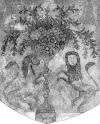
|
Coat of arms of the Toptani (1760) The Toptani were a wealthy land-owning family in Central Albania who ruled over the area in and around Tirana for the better part of the 19th century. Originally from Krujë, they would become one of the most powerful and influential families in all of Albania. Prominent members included Abdi and Murad, both signatories of the Declaration of Independence, the former having served as Minister of Finances in the Provisional Government and the latter being a distinguished sculptor and poet. Murad married into the Frashëri household a woman by the name of Asije, niece of Naim Frashëri. His brother, Refik, was chairman of the patriotic club "Bashkimi" and a participating delegate at the Congress of Manastir. Their father, Said (Seremedin Seid), was an intellectual in his own right, being a founding member of the Istanbul Committee, which advocated for an autonomous Albanian region within the Ottoman Empire. Essad Pasha served as Prime Minister and his brother Gani Bey was an Ottoman officer and adjutant of Sultan Abdülhamid II. Fuad served as mayor of Tirana. Sadije married Xhemal Pasha of the Zogolli clan, inherently becoming queen mother to the future King of Albania, Zog I. The family coat of arms appears in a scanned document from the 18th century and can be described as follows:
|

|
Insignia of the Gjonmarkaj (19th century) The Gjonmarkaj were, until April 7, 1939, and the advent of Communism, the rulers of Mirdita. Hailing from the Dukagjini clan, one of the oldest and most powerful families of Albanian nobility, their ancestral tree diverged into three main branches: Prenk Pasha, Lleshi i Zi and Prenk Markola. Being inherent custodians of the Kanun, they commanded respect primarily as arbiters and administrators of justice, rather than rulers in the traditional sense. Prenk Bib Doda, from the Prenk Pasha branch, served as Minister of Foreign Affairs in Turhan Përmeti's government. Unfortunately, he left no heir and with his passing, that branch of the Gjonmarkaj died out altogether. The lineage of Lleshi i Zi continued through Kapidan Marka Gjoni, the leader of Mirdita's self-government, and his son Gjon Marka Gjoni. Major Prenk Gjonmarkaj, from Prenk Markola's branch, held the post of Deputy Minister of the Interior during the war.[40] The family's heraldic achievement is depicted in the 1980 monograph titled "La casa dei Gjomarkaj", published in Palermo by Maria Greco.[41]
|




